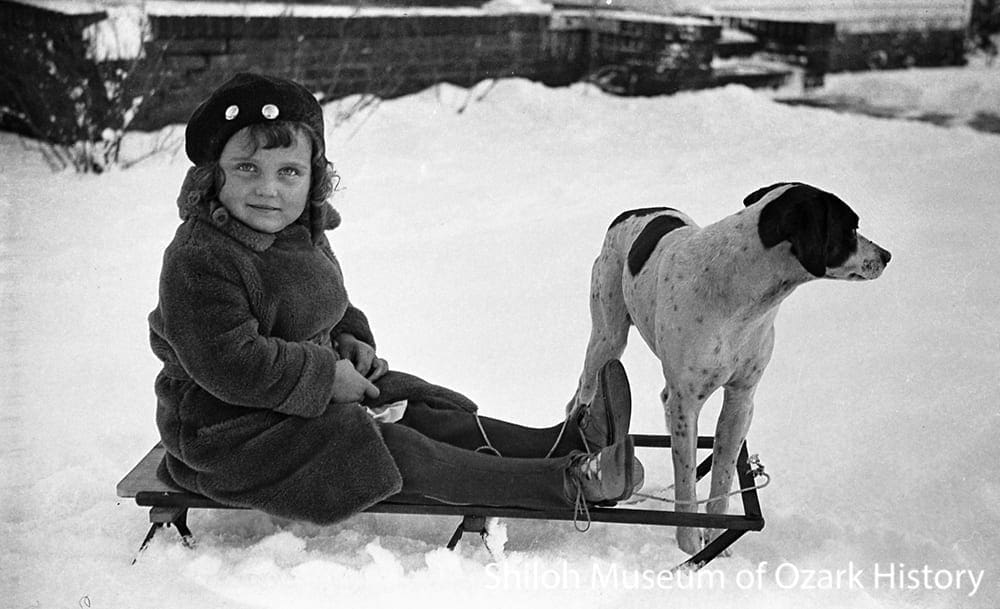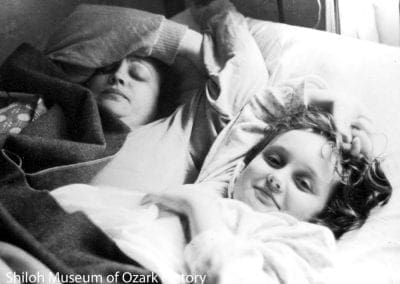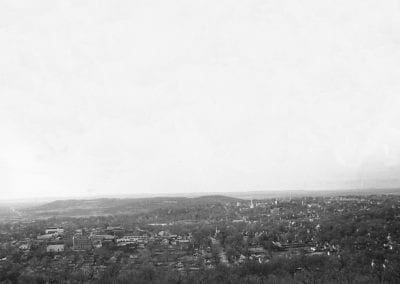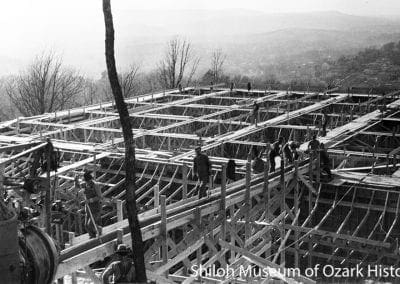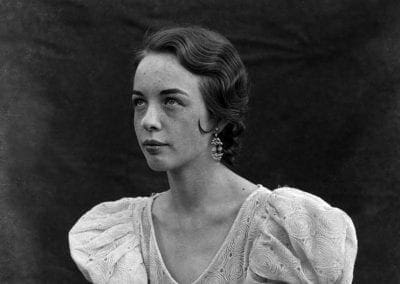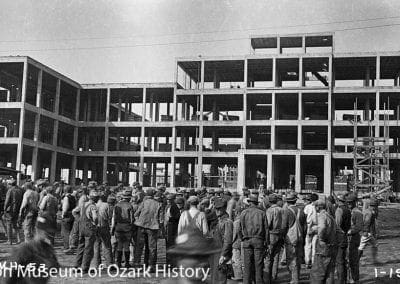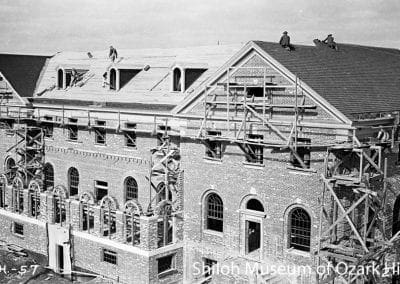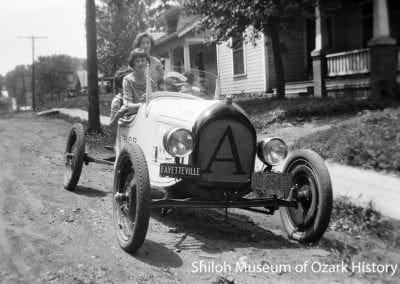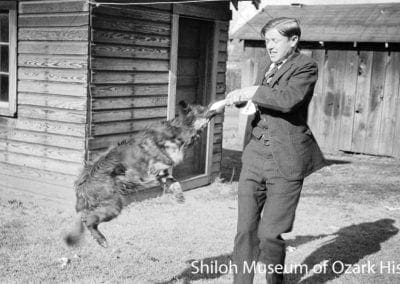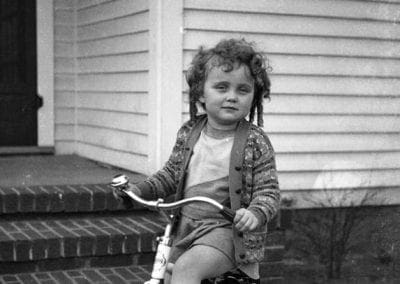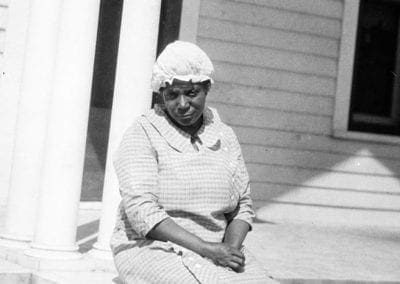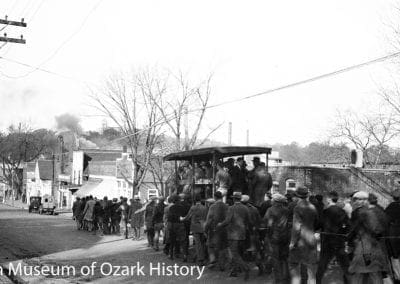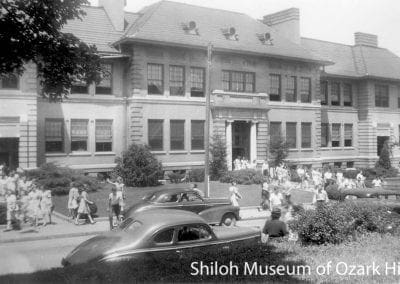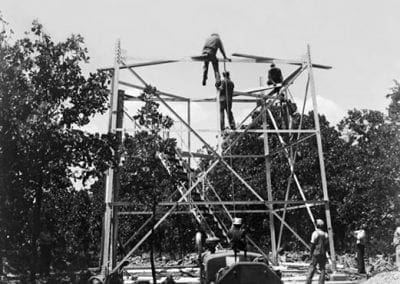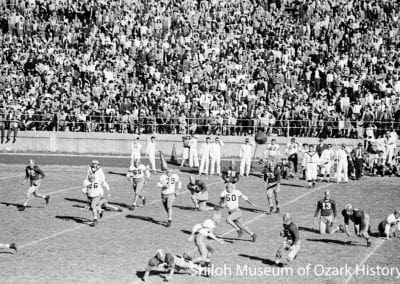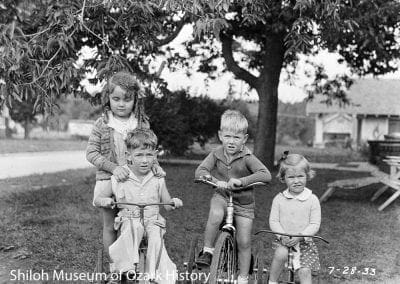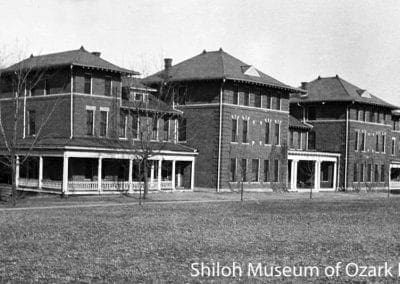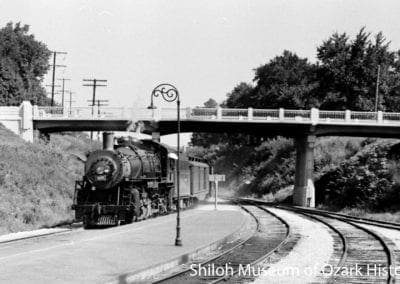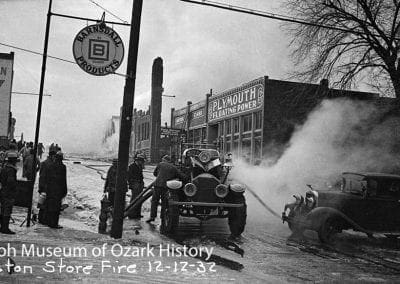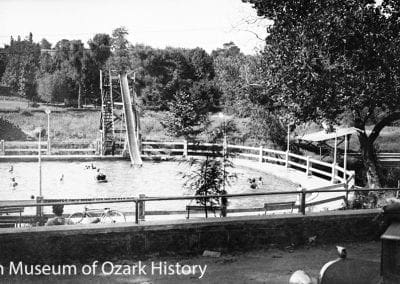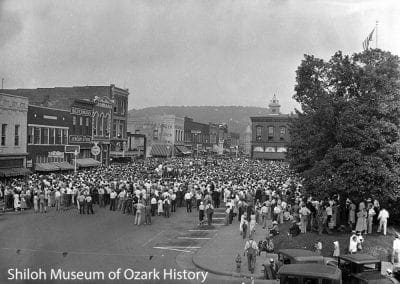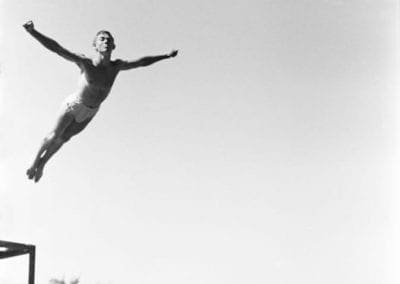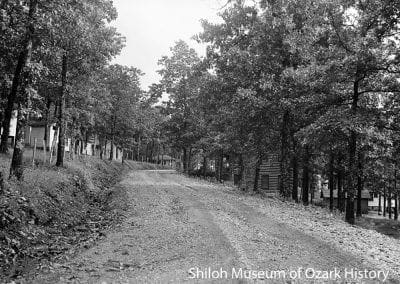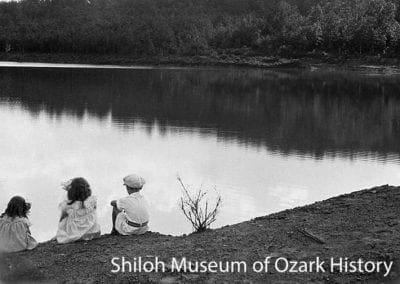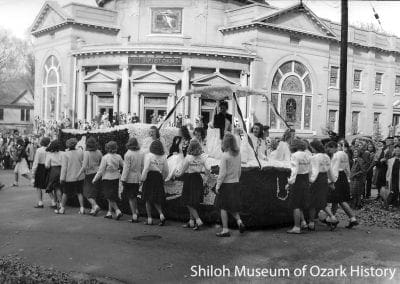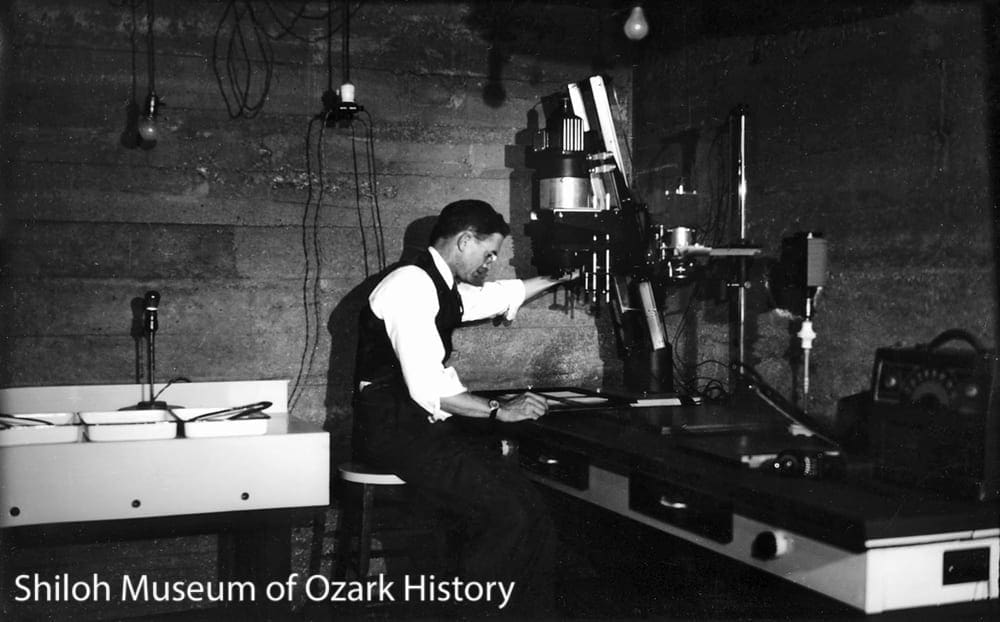Carl Smith's Fayetteville
Online ExhibitWhen Carl Smith looked through the lens of his camera, he found a fascinating world. He saw scenes of hometown life, massive engineering projects, and a precious daughter. Because of his talent with the camera we are able to glimpse one man’s life in Fayetteville in the first half of the twentieth century.
William Carl Smith (1900-1973) was born in Farmington to Moses Elbert “Eb” Smith and Minnie Lee Blackburn, a member of the prominent Blackburn family at War Eagle. When Eb died a few years after Carl’s birth, Minnie moved the family to Fayetteville.
Carl graduated from the University of Arkansas in 1922 with a degree in civil engineering. He worked on several large construction projects in the area, including the Veterans Hospital in Fayetteville and the parks at Devil’s Den and Lake Wedington. In 1926 he married Frances Slaughter with whom he had a daughter, Ada Lee.
He was a military man, serving as an Army officer in Europe during World War II, where he received several honors including the Bronze Star and the British Distinguished Service Order. Following the war he was a commanding officer in the 142nd Field Artillery Battalion of the Arkansas National Guard for six years.
In later years he served as water superintendant and city engineer for the City of Fayetteville and as director of Fayetteville Building and Loan. Through it all he kept his camera at the ready.

Carl Smith’s 1950s Zeis Ikon Nettar II camera and snapshots. Bill Shook Collection and Ada Lee Shook Collection
We have Minnie to thank for inspiring Carl’s interest in photography. She loved to take photos with the camera Eb gave her, no doubt inspiring her young son.
Our most grateful thanks goes to Carl’s daughter Ada Lee Smith Shook who shared memories of her family and generously donated hundreds of his images to the Shiloh Museum.
When Carl Smith looked through the lens of his camera, he found a fascinating world. He saw scenes of hometown life, massive engineering projects, and a precious daughter. Because of his talent with the camera we are able to glimpse one man’s life in Fayetteville in the first half of the twentieth century.
William Carl Smith (1900-1973) was born in Farmington to Moses Elbert “Eb” Smith and Minnie Lee Blackburn, a member of the prominent Blackburn family at War Eagle. When Eb died a few years after Carl’s birth, Minnie moved the family to Fayetteville.
Carl graduated from the University of Arkansas in 1922 with a degree in civil engineering. He worked on several large construction projects in the area, including the Veterans Hospital in Fayetteville and the parks at Devil’s Den and Lake Wedington. In 1926 he married Frances Slaughter with whom he had a daughter, Ada Lee.
He was a military man, serving as an Army officer in Europe during World War II, where he received several honors including the Bronze Star and the British Distinguished Service Order. Following the war he was a commanding officer in the 142nd Field Artillery Battalion of the Arkansas National Guard for six years.
In later years he served as water superintendant and city engineer for the City of Fayetteville and as director of Fayetteville Building and Loan. Through it all he kept his camera at the ready.

Carl Smith’s 1950s Zeis Ikon Nettar II camera and snapshots. Bill Shook Collection and Ada Lee Shook Collection
We have Minnie to thank for inspiring Carl’s interest in photography. She loved to take photos with the camera Eb gave her, no doubt inspiring her young son. Our most grateful thanks goes to Carl’s daughter Ada Lee Smith Shook who shared memories of her family and generously donated hundreds of his images to the Shiloh Museum.
Carl Smith's Community

Track meet, University of Arkansas, Fayetteville, 1941. Carl Smith, photographer. Ada Lee Shook Collection ( S-98-85-1798)
Camera in hand, Carl Smith recorded the town he loved.
One of Carl’s major interests was in the goings-on at Fayetteville High School and the University of Arkansas, his alma maters. During homecoming he captured scenes of float builders, marchers, and parades. At sporting events he caught the scramble of football players on the field and the moment when a racer crossed the finish line.
Around town he snapped images of buildings, streets, and new homes under construction. At one point he even hopped into an airplane to take a few aerial shots of the downtown and surrounding countryside. A bird’s-eye view of the University’s campus shows just a few buildings surrounding Old Main and an empty field where the Student Union now stands.
Of course some of the places he documented have changed over time. Gone are the dirt roads on Mt. Sequoyah and the ornate First Baptist Church. The city swimming pool at Wilson Park looks quite different as do a few of the buildings on the square. Carl’s photos are a legacy of Fayetteville as it used to be.
Carl Smith's Community

Track meet, University of Arkansas, Fayetteville, 1941. Carl Smith, photographer. Ada Lee Shook Collection ( S-98-85-1798)
Camera in hand, Carl Smith recorded the town he loved.
One of Carl’s major interests was in the goings-on at Fayetteville High School and the University of Arkansas, his alma maters. During homecoming he captured scenes of float builders, marchers, and parades. At sporting events he caught the scramble of football players on the field and the moment when a racer crossed the finish line.
Around town he snapped images of buildings, streets, and new homes under construction. At one point he even hopped into an airplane to take a few aerial shots of the downtown and surrounding countryside. A bird’s-eye view of the University’s campus shows just a few buildings surrounding Old Main and an empty field where the Student Union now stands.
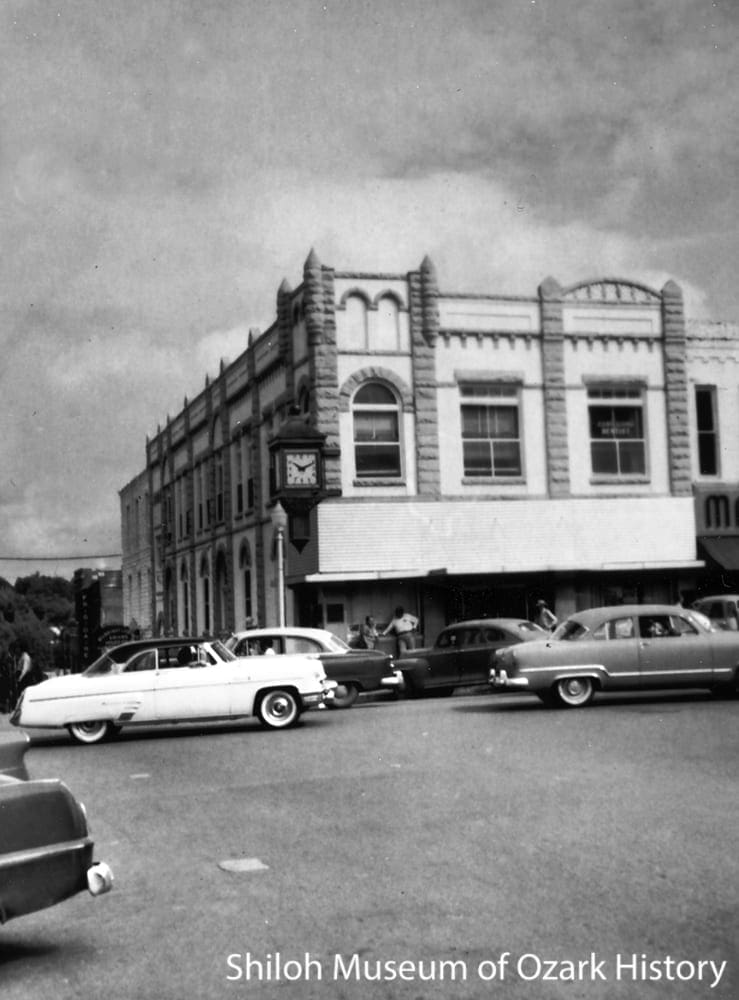
First National Bank, northeast corner of Block & Center Streets, Fayetteville, 1950s. Carl Smith, photographer. Ada Lee Shook Collection (S-2001-101-76)
Of course some of the places he documented have changed over time. Gone are the dirt roads on Mt. Sequoyah and the ornate First Baptist Church. The city swimming pool at Wilson Park looks quite different as do a few of the buildings on the square. Carl’s photos are a legacy of Fayetteville as it used to be.
Carl Smith's Construction Projects
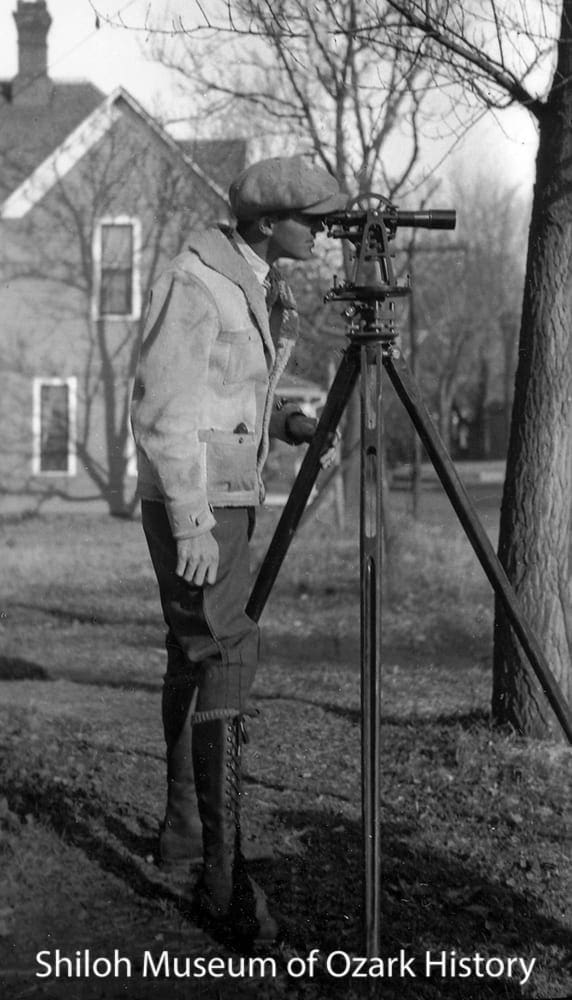
Carl Smith with his surveying equipment at his mother’s home on Locust Street, Fayetteville, about 1925. Ada Lee Shook Collection (S-98-85-39)
Building a Life, Building a Town
After receiving his civil engineering degree from the University of Arkansas in 1922, Carl worked on a variety of area engineering projects: sewer and paving improvements in Harrison; paving, water, and sewer projects in Fayetteville; and the waterworks plant in Prairie Grove. He went further afield, working for a sulfur company in Freeport, Texas, and as a resident engineer for a construction company in Monett, Missouri.
Carl’s biggest jobs came during the Great Depression, when the Federal government sponsored massive construction projects as a way to put people to work. From 1932 to 1933 he assisted with the building of the U.S. Veterans Hospital complex, which included the administration building, the dining hall, the nurses’ quarters, the boiler house, and various on-site residences.
From 1936 to 1938 he worked on another Federal project, the construction of the Lake Wedington recreational area just west of Fayetteville. As project engineer he laid out the road into the work site and built the 102-acre lake with its 1,000-feet-long earthen dam.
After World War II Carl served as water superintendent and city engineer for the City of Fayetteville. He advocated projects that would increase the water supply of a growing town and oversaw additions and renovations at the city hospital, the airport, and in residential areas.
Carl Smith's Construction Projects

Carl Smith with his surveying equipment at his mother’s home on Locust Street, Fayetteville, about 1925. Ada Lee Shook Collection (S-98-85-39)
Building a Life, Building a Town
After receiving his civil engineering degree from the University of Arkansas in 1922, Carl worked on a variety of area engineering projects: sewer and paving improvements in Harrison; paving, water, and sewer projects in Fayetteville; and the waterworks plant in Prairie Grove. He went further afield, working for a sulfur company in Freeport, Texas, and as a resident engineer for a construction company in Monett, Missouri.
Carl’s biggest jobs came during the Great Depression, when the Federal government sponsored massive construction projects as a way to put people to work. From 1932 to 1933 he assisted with the building of the U.S. Veterans Hospital complex, which included the administration building, the dining hall, the nurses’ quarters, the boiler house, and various on-site residences.
From 1936 to 1938 he worked on another Federal project, the construction of the Lake Wedington recreational area just west of Fayetteville. As project engineer he laid out the road into the work site and built the 102-acre lake with its 1,000-feet-long earthen dam.
After World War II Carl served as water superintendent and city engineer for the City of Fayetteville. He advocated projects that would increase the water supply of a growing town and oversaw additions and renovations at the city hospital, the airport, and in residential areas.
Carl Smith's Family
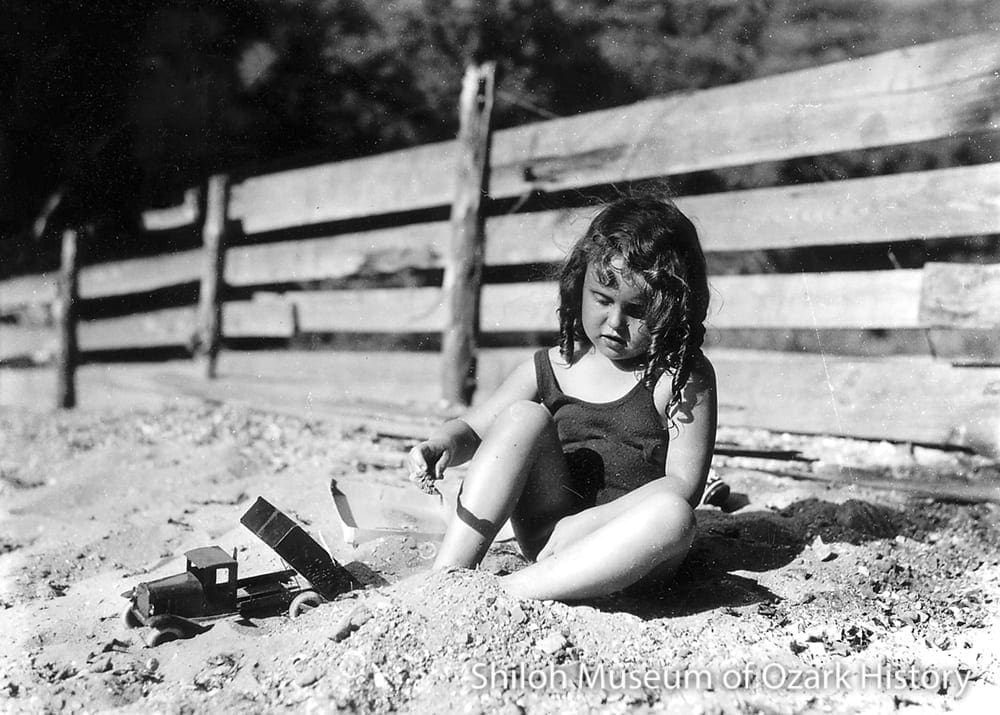
Ada Lee Smith in her sandbox, Fayetteville, 1933. Carl Smith, photographer. Ada Lee Shook Collection (S-98-85-336)
Was there ever a child in Northwest Arkansas more photographed than Ada Lee?
From the moment she was born in 1928 Carl began documenting his daughter’s life. There are snapshots of her with her toys, pets, outfits, and bicycles. Ada Lee on Christmas morning, on her birthday, playing in her sandbox, swimming in the creek.
The neighborhood kids weren’t left out. Not only did Carl take their picture, he also built go-carts, made playhouses, and organized adventures. In later years Ada Lee remembered, “Oh, he was a great dad! A lot of fun! He made kites for all the neighborhood kids out of tissue paper and sticks, with a tail made of rags. He knew exactly how to make them fly. He took all us kids for walks on Mount Sequoyah. He played with us in the sandbox. He made roads in the sand, and used twigs from our spirea bush to make trees.”
One of Carl’s interests was formal portraiture, as evidenced by the many posed shots he took of children and adults. He’d sit his subjects outside, perhaps with a dark blanket as a backdrop, and when the light was just right, capture a quiet moment.
Carl Smith's Family

Ada Lee Smith in her sandbox, Fayetteville, 1933. Carl Smith, photographer. Ada Lee Shook Collection (S-98-85-336)
Was there ever a child in Northwest Arkansas more photographed than Ada Lee?
From the moment she was born in 1928 Carl began documenting his daughter’s life. There are snapshots of her with her toys, her pets, her outfits, and her bicycles. Ada Lee on Christmas morning, on her birthday, playing in her sandbox, swimming in the creek.
The neighborhood kids weren’t left out. Not only did Carl take their picture, he also built go-carts, made playhouses, and organized adventures. In later years Ada Lee remembered, “Oh, he was a great dad! A lot of fun! He made kites for all the neighborhood kids out of tissue paper and sticks, with a tail made of rags. He knew exactly how to make them fly. He took all us kids for walks on Mount Sequoyah. He played with us in the sandbox. He made roads in the sand, and used twigs from our spirea bush to make trees.”
One of Carl’s interests was formal portraiture, as evidenced by the many posed shots he took of children and adults. He’d sit his subjects outside, perhaps with a dark blanket as a backdrop, and when the light was just right, capture a quiet moment.
Photo Gallery
Frances Slaughter Smith (left) with daughter Ada Lee, Fayetteville, about 1940. Carl Smith, photographer. Ada Lee Shook Collection (S-98-167-5)
Looking west from Mt. Sequoyah, Fayetteville, 1940s. Carl Smith, photographer. Ada Lee Shook Collection (S-98-85-1356)
Reservoir site, Fayetteville Water and Sewer Works, Mt. Sequoyah, Fayetteville, January 1927. Carl Smith, photographer. Ada Lee Shook Collection (S-98-85-1397)
Pauline Bevers Kincade Paschal, Fayetteville, about 1928. Carl Smith, photographer. Ada Lee Shook Collection (S-98-85-254)
Spreading concrete, Mountain Street district, Fayetteville, September 1925. Carl Smith is standing second from left. Carl Smith, photographer. Ada Lee Shook Collection (S-98-85-1696)
Administration building construction, U.S. Veterans Hospital, North College Avenue, Fayetteville, January 1933. Carl Smith, photographer. Ada Lee Shook Collection (S-98-85-1136)
Administration building construction, U.S. Veterans Hospital, North College Avenue, Fayetteville, February 1933. Carl Smith, photographer. Ada Lee Shook Collection (S-98-85-1140)
“Arkansas Traveler” car built by Carl Smith, Locust Street, Fayetteville, about 1924. Carl Smith, photographer. Ada Lee Shook Collection (S-98-85-1819)
Frank Smith with his brother Carl’s dog, Static, Fayetteville, 1920s. Carl Smith, photographer. Ada Lee Shook Collection (S-98-85-696)
Ada Lee Smith Shook in her Buster Brown shoes, Carl Smith home, Fayetteville, 1932. Carl Smith, photographer. Ada Lee Shook Collection (S-98-85-356)
Rosie, the Slaughter family housekeeper, Ada Slaughter home, Fayetteville, about 1930. Carl’s daughter remembered that at lunchtime, Rosie sat at the kitchen counter while Ada sat at the table and they “talked and talked and laughed a lot.” Carl Smith, photographer. Ada Lee Shook Collection (S-98-85-1013)
University of Arkansas football game rally, Dickson Street, Fayetteville, about 1920. Carl Smith, photographer. Ada Lee Shook Collection (S-98-85-1440)
Fayetteville High School, corner of School and Center Streets, Fayetteville, about 1940. Carl Smith, photographer. Ada Lee Shook Collection (S-98-85-1999)
Construction at Lake Wedington, 1936-1938. Carl Smith, photographer. Ada Lee Shook Collection (S-98-85-1270)
Razorback football game, University of Arkansas, Fayetteville, about 1940. Carl Smith, photographer. Ada Lee Shook Collection (S-98-85-1783)
Ada Lee Smith Shook (standing) with Dicky Watkins, Herman Tuck, and Joanne Tuck, Carl Smith home, Fayetteville, July 1933. Carl Smith, photographer. Ada Lee Shook Collection (S-98-85-290)
Carnall Hall, University of Arkansas, Fayetteville, about 1920. Carl Smith, photographer. Ada Lee Shook Collection (S-98-85-1385)
Frisco Railroad train, Lafayette Street underpass, Fayetteville, about 1940. Carl Smith, photographer. Ada Lee Shook Collection (S-98-85-1706)
Boston Store fire, west side of the square, Fayetteville, December 1932. Carl Smith, photographer. Ada Lee Shook Collection (S-98-85-1661)
Swimming pool, Wilson Park, Fayetteville, about 1930. Carl Smith, photographer. Ada Lee Shook Collection (S-98-85-1078)
Crowd on the northeast corner of the square, Fayetteville, about 1930. Carl Smith, photographer. Ada Lee Shook Collection (S-98-85-57)
Diver at city swimming pool, Wilson Park, Fayetteville, about 1940. Carl Smith, photographer. Ada Lee Shook Collection (S-98-85-1753)
Mt. Sequoyah, Fayetteville, about 1923. Carl Smith, photographer. Ada Lee Shook Collection (S-98-85-574)
Ada Lee Smith (middle) and others at Lake Wilson, Fayetteville, 1933. Carl Smith, photographer. Ada Lee Shook Collection (S-98-85-581)
Credits
“Lt. Col. Smith Wears British Honor Medal,” [possibly] Fayetteville Daily Democrat, 1946?
McGlumphy, Veronica. “Wiggan’s Hole: History of Lake Wedington.” Flashback, Vol. 58, No. 1 (Spring 2008).
Miller, Leaford. “Urgency of Water Situation Here Stressed by Official.” Northwest Arkansas Times, June 26, 1956.
“Mountain Street District Paving Opened to Public,” Fayetteville Daily Democrat, September 18, 1925.
Resettlement Administration, Washington, D.C. Letters to William Carl Smith, December 16, 1935, and May 20, 1936. Shiloh Museum Manuscript Collection #79, Box 3, File 1.
Rucker, Steve. Email re: Carl Smith’s military service, July 18, 2001.
Shook, Ada Lee. “William Claiborne Smith.” History of Washington County Arkansas, 1989.
USDA Soil Conservation Service, Washington D.C. Personal Data Memorandum for Carl Smith, September 1, 1939. Shiloh Museum Manuscript Collection #79, Box 3, File 1.
Young, Susan. “Carl Smith and His Photos.” Shiloh Scrapbook, Summer 2001.
Young, Susan. Notes from an interview with Ada Lee Smith Shook, 2001.
Credits
“Lt. Col. Smith Wears British Honor Medal,” [possibly] Fayetteville Daily Democrat, 1946?
McGlumphy, Veronica. “Wiggan’s Hole: History of Lake Wedington.” Flashback, Vol. 58, No. 1 (Spring 2008).
Miller, Leaford. “Urgency of Water Situation Here Stressed by Official.” Northwest Arkansas Times, June 26, 1956.
“Mountain Street District Paving Opened to Public,” Fayetteville Daily Democrat, September 18, 1925.
Resettlement Administration, Washington, D.C. Letters to William Carl Smith, December 16, 1935, and May 20, 1936. Shiloh Museum Manuscript Collection #79, Box 3, File 1.
Rucker, Steve. Email re: Carl Smith’s military service, July 18, 2001.
Shook, Ada Lee. “William Claiborne Smith.” History of Washington County Arkansas, 1989.
USDA Soil Conservation Service, Washington D.C. Personal Data Memorandum for Carl Smith, September 1, 1939. Shiloh Museum Manuscript Collection #79, Box 3, File 1.
Young, Susan. “Carl Smith and His Photos.” Shiloh Scrapbook, Summer 2001.
Young, Susan. Notes from an interview with Ada Lee Smith Shook, 2001.



